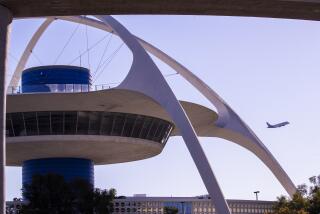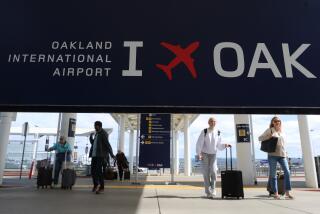FAA Forces Airport to Ban Eastward Takeoffs
- Share via
At the insistence of the Federal Aviation Administration, Burbank airport authorities have barred airline pilots from taking off toward the east--over Glendale and Pasadena, a policy an airport spokesman warned will sometimes force airlines to remove passengers from jetliners.
Under Santa Ana wind conditions, if some runways cannot be used, jetliners loaded with fuel for long flights may be too heavy to take off on the remaining available runways, which slope uphill, and will have to lighten their loads by reducing the number of passengers, airport spokesman Victor Gill said.
The problem has its roots in the location of the 55-year-old airport terminal. It is only 313 feet from a runway at some points, less than half the safety zone of 750 feet required by modern safety regulations. The FAA has been waiting several years for the Burbank-Glendale-Pasadena Airport Authority to replace it.
After the airport authority’s plans for a new terminal collapsed in December, however, the federal agency began insisting on immediate changes in the airport layout and procedures until a new terminal is built. It is expected to be several years before one is ready.
The president of the airport authority, Robert W. Garcin, has warned that the financial burden of meeting the FAA’s demands and adverse court rulings on noise-nuisance lawsuits threaten the airport’s existence.
A recent private meeting at the airport was attended by three members of the airport authority, five FAA officials and all four people on a committee representing airlines that fly out of the airport.
At the meeting, the FAA officials demanded an immediate ban on eastbound takeoffs, Gill said.
The ban went into effect within minutes of the end of the meeting.
The rule will not please anti-noise protesters. San Fernando Valley homeowners groups and the city of Los Angeles have been trying to encourage takeoffs toward the east to reduce jetliner noise over the San Fernando Valley by routing more flights over Glendale and Pasadena.
The FAA first requested such a ban in February on grounds that planes taking off toward the east come too close to the terminal and reach takeoff speed just as they pass an area where parked jetliners load and unload passengers between the runway and the building.
The authority contended that, in the past, the FAA took sole charge of such aircraft traffic rules, limiting airport operators’ authority to ground facilities.
On March 13, the manager of the airports division of the FAA’s western regional office, Herman C. Bliss, wrote to the authority, again asking it to enact such a rule, and demanding that the authority come up with specific plans within 30 days to implement other requested changes.
Those include converting 1,457 auto parking spaces into aircraft parking space to move jetliners farther from the runways. The parking spaces generated $1.7 million in fees last year, one of the chief financial supports for the airfield. Last week an airport authority committee recommended that two large parking areas be converted into a passenger boarding area. However, the committee opposes the FAA’s demand that it convert another 800 parking spaces into a taxiway, said Tom Greer, director of airport services.
The recommendations will be made to the full airport authority Monday.
As far as the airport authority is concerned, Gill said, it is not acting on it own in forbidding takeoffs to the east but is enforcing an FAA request “pending forthcoming rule-making by the FAA on this subject.”
The rule applies to all multi-engine planes weighing more than 12,500 pounds, a category that covers all commercial airliners and some private business jets. It is expected to remain in force until the existing terminal is razed. No site has been chosen for a new building.
The ban will cause problems for some flights during Santa Ana winds, Gill said, forcing airlines to remove passengers from flights or to forbid them to board.
The airport has two runways. One runs roughly from north to south; the southern end is slightly lower. The other, which is 828 feet shorter, runs east and west, and the eastern end is lower.
Normally, the wind blows from the west or southwest. Pilots try to take off into the wind, or with the wind from the side, to increase the lift on the wings. A wind from the rear decreases lift.
Consequently, airline pilots--who make the final decision--take off from north to south about 90% of the time at Burbank, preferring the longer runway with the downhill slope.
More to Read
Sign up for Essential California
The most important California stories and recommendations in your inbox every morning.
You may occasionally receive promotional content from the Los Angeles Times.










